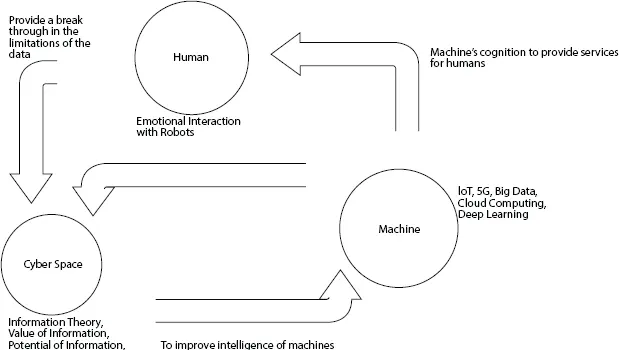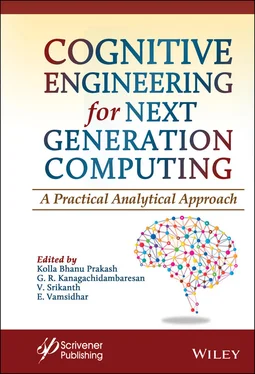Last, but definitely not least, we’d like to thank our readers, and we hope our work inspires and guides them.
EditorsKolla Bhanu PrakashG. R. KanagachidambaresanV. SrikanthE. Vamsidhar
1
Introduction to Cognitive Computing
Vamsidhar Enireddy*, Sagar Imambi† and C. Karthikeyan‡
Department of Computer Science and Engineering, Koneru Lakshmaiah Education Foundation, Guntur, India
Abstract
Cognitive computing is an interdisciplinary subject that brings under its umbrella several techniques such as Machine learning, big data analytics, artificial intelligence, analytics, natural language processing, and probability and statistics to gather information and understand it using different senses and learning from their experience. Cognitive computing helps humans in taking the right decisions at a right time helping the people to grow in their respective fields. In this chapter, we are going to discuss cognitive computing and the elements involved in it. Further, we will learn about the components and hypothesis generation and scoring of it.
Keywords:Artificial intelligence, cognition, cognitive computing, corpus, intuitive thinking, hypothesis generation, machine learning
1.1 Introduction: Definition of Cognition, Cognitive Computing
The term Cognition is defined as “The procedure or the method of acquiring information and understanding through experience, thought and the senses” [1]. It envelops numerous parts of procedures and intellectual functions, for example, development of information, thinking, reasoning, attention, decision making, evaluating the decisions, problem-solving, computing techniques, judging and assessing, critical thinking, conception, and creation of language. This process produces new information using existing information. A large number of fields especially psychology, neuroscience, biology, philosophy, psychiatry, linguistics, logic, education, anesthesia, and computer science view and analyze the cognitive processes with a diverse perspective contained by dissimilar contexts [2].
The word cognition dates to the 15th century, derived from a Latin word where it meant “thinking and awareness” [3]. The term comes from cognitio which means “examination, learning or knowledge”, derived from the verb cognosco, a compound of con (‘with’), and gnōscō (‘know’). The latter half, gnōscō, itself is a cognate of a Greek verb, gi(g)nόsko (γι(γ)νώσκω, ‘I know,’ or ‘perceive’) [4, 5].
Aristotle is probably the first person who has shown interest to study the working of the mind and its effect on his experience. Memory, mental imagery, observation, and awareness are the major areas of cognition, hence Aristotle also showed keen interest in their study. He set incredible significance on guaranteeing that his examinations depended on exact proof, that is, logical data that is assembled through perception and principled experimentation [6]. Two centuries later, the basis for current ideas of comprehension was laid during the Enlightenment by scholars, like, John Locke and Dugald Stewart who tried to build up a model of the psyche in which thoughts were obtained, recalled, and controlled [7].
As Derived from the Stanford Encyclopedia of Philosophy the Cognitive science can be defined as “Cognitive science is the interdisciplinary study of mind and intelligence, embracing philosophy, psychology, artificial intelligence, neuroscience, linguistics, and anthropology.”
The approach for cognitive computing depends on understanding the way how the human brain can process the information. The main theme or idea of a cognitive system is that it must able to serve as an associate for the human’s rather than simply imitating the capabilities of the human brain.
1.2 Defining and Understanding Cognitive Computing
Cognitive computing can be defined as hardware and software to learn so that they need not be reprogrammed and automate the cognitive tasks [11]. This technology brings under its cover many different technologies such as Artificial Intelligence, Machine Learning, Advanced Analytics, Natural Language Processing, Big Data Analytics, and Distributed Computing. The impact of this technology can be seen in health care, business, decision making, private lives, and many more.
Two disciplines are brought together with cognitive computing
1 Cognitive Science
2 Computer Science.
The term cognitive science refers to the science of mind and the other is a computational approach where the theory is put into practice.
The ultimate objective of cognitive computing is that it must able to replicate the human thinking ability in a computer model. Using technologies like machine learning, natural language processing, advanced analytics, data mining, and statistics had made these things possible where the working of the human brain can be mimicked [8].
From a long back, we can construct the computers which perform the calculations at a high speed, also able to develop supercomputers which can do calculations in a fraction of second, but they are not able to perform the tasks as humans do like the reasoning, understanding and recognizing the objects and images.
Cognitive researchers discover the mental capability of humans through an examination of the aspects like memory, emotion, reasoning, perception, and language [12]. Figure 1.1shows the Human centered cognitive cycle. On analysis, the human being’s cognitive process can be divided into two stages. One is the humans use their sensory organs to perceive the information about their surrounding environment and become aware of it, in this manner humans gather the input from the outside environment. The second stage is that this information is carried by the nerves to the brain for processing and the process of storing, analyzing, and learning takes place [13].

Figure 1.1 Human-centered cognitive cycle.
Many researchers and scientists from many years had tried to develop the systems that can mimic the human thoughts and process, but it is relatively complex to transform the intricacy of thinking of humans and actions into systems. Human beings have a lot of influence on them such as perception, culture, sentiment, lifestyle, and implicit beliefs about their surrounding environment. Cognition is the basic framework that not only leverages the way we imagine but also the way we behave and the way we make decisions. To understand this let us consider some examples that we see around us. Why there are different recommendations and approaches between the treatments for the same disease with different doctors? Why do people with the same background born and brought up in the same family have different views and opinions about the world?
Dr. Daniel Kahneman is a Nobel Prize winner in economic sciences in 2002 had paved a way for the cognitive computing approach. He had made a lot of research in the area of psychology of judgment and decision making [11]. The approach is divided into two systems: 1. Intuitive thinking and 2. Controlled andrulecentric thinking.
System 1: Intuitive thinking
In this system, reasoning occurs in the human brain naturally. The conclusions are drawn using our instincts. In System 1 human thinking begins the moment they are born. Humans learn to notice and recognize the things and their relationship by themselves. To illustrate this we consider some examples for better understanding. The children correlate their parent’s voices with safety. People correlate strident sound with danger. At the same time, we can see that children with a harsh mother are not going to have a similar experience with the voice of the mother as the child with a good mother. Humans learn more things over time and continue assimilating their thoughts into their mode of working in the world. The chess grandmaster can play the game with their mind anticipating their opponent’s move and also they can play the game entirely in their mind without any need to touch the chessboard. The surrounding environment plays a major role in a person’s behavior, it affects their emotions and attitudes. A person brought up in treacherous surroundings, have a different attitude about the people compared to a person brought up in healthy surroundings. In System1 using the perception, we gather the data about the world and connect the events. In the cognitive computing point of view, this System 1 had taught the way how we gather information from the surroundings helps us to conclude. Figure 1.2shows collaboration between the Intuitive thinking and analysis.
Читать дальше













